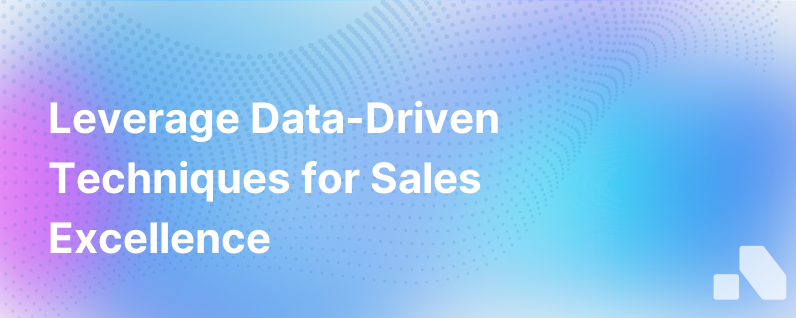Data Driven Sales
Published on September 5, 2023 by David Zhang
In today's hyper-competitive business landscape, sales strategies based on intuition or vague understandings of the market won't cut it. At the core of today's most successful sales organizations is a powerful engine driving them towards efficiency and growth: data. Data-driven sales leverage insights gleaned from hard evidence, letting teams make more informed decisions and foster a culture of continual improvement. In this piece, we’ll unpack what data-driven sales entail, its importance, and how businesses can implement it to revolutionize their strategies in B2B contexts.
Understanding Data-Driven Sales
Data-driven sales is the practice of using quantifiable metrics and information to guide sales processes, strategies, and decision-making. It covers everything from lead generation and qualification to forecasting, customer engagement, performance monitoring, and optimization. The goal is simple yet profound: to replace guesswork and assumptions with factual insights and actionable intelligence.
The Importance of Data-Driven Sales
With the advent of technology in the sales domain, there's an abundance of data available — customer demographics, interaction tracking, sales results, and much more. Using this data effectively yields myriad benefits, including but certainly not limited to:
-
Increased Efficiency: Sales data can highlight the most profitable customer segments or the most effective sales channels. With these insights, sales efforts can be focused where they are most likely to generate a high return on investment.
-
Enhanced Predictability: Predictive analytics can give a foretaste of upcoming trends, customer behavior, and revenue potential. This insight assists in managing stock, aligning marketing efforts, and managing resources.
-
Personalized Selling: With rich data at your disposal, sales approaches can be highly tailored to individual prospects. This personalization not only increases conversion rates but can also lead to better customer retention.
-
Informed Strategic Decisions: Sales data can reveal market patterns, helping guide the strategic direction. It can also validate or question the success of past decisions, such as the effectiveness of a recent marketing campaign.
Pillars of a Data-Driven Sales Approach
To materialize the full benefits of a data-driven sales approach, several key elements must be in place.
Quality Data Collection: It all starts with data collection. Implementing tools and systems to collect high-quality data is essential. This includes using CRMs, sales enablement platforms, and other analytics tools.
Data Analysis and Interpretation: Collecting data is moot without the mechanism to analyze and interpret it. This is where business intelligence tools can be invaluable. They provide actionable insights and facilitate decision-making based on the data collected.
Sales Process Integration: Once you have the insights, the next step is to integrate these into your sales processes. This might involve direct actions, such as personalizing communication based on previous interactions or broader strategies like pivoting to a new customer segment.
Ongoing Optimization: The 'set it and forget it' mentality has no place here. A data-driven sales strategy requires continuous monitoring, testing, and adjustment. The data should feed a process of continual iterations and improvements.
Implementing a Data-Driven Sales Strategy
So, how do companies implement a data-driven sales strategy that moves the needle? Here’s a roadmap outlining crucial steps:
-
Define Your Primary Data Points: Establish which metrics are most relevant to your business goals. Common metrics include conversion rates, average deal size, lead velocity, and customer lifetime value.
-
Set Clear Sales Objectives: Align your sales objectives with your business goals and assess them against the data. Concrete objectives can include increasing conversion rates by X% or growing average deal size by Y%.
-
Equip Your Team with the Right Tools: Adopt sales technology that can capture the necessary data. This includes a robust CRM platform, sales engagement tools, and advanced analytic software.
-
Train Teams on Data Literacy: Ensure your sales teams understand how to read and act on the insights generated. Provide training on the tools they’ll use and how to interpret the data these tools provide.
-
Create a Central Data Repository: All data should feed into a single source of truth. This centralization facilitates better analysis and insights while avoiding data silos that could skew the perception.
-
Analyze and Act on the Insights: Turn insights into action through strategic changes and tactical moves. Decide on immediate steps for sales reps and longer-term strategic shifts for managers and leaders based on the data.
-
Implement a Culture of Testing: Embed a culture of A/B testing within your sales team to find the most effective messages, channels, and strategies.
-
Regularly Review Your Data Approach: Constantly reevaluate your data strategy. Look at what’s working and what’s not, and refine your approach accordingly.
Challenges in a Data-Driven Approach and How to Overcome Them
Transitioning to a data-driven approach isn't without challenges. Some of the common obstacles include data overload, data quality issues, resistance to change, and a lack of proper analysis skills within the sales team. Overcoming these challenges requires a strategic approach to data management, an emphasis on data quality over quantity, change management to foster buy-in from all team members, and investment in training and development.
Conclusion
In the age of information, harnessing data to fuel sales efforts is not just a luxury but a necessity for B2B success. Implementing a data-driven approach allows organizations to hone in on what works, eliminate wasteful practices, and ultimately, carve a pathway toward sustainable growth and revenue generation.
In the pursuit of building a data-driven sales infrastructure, platforms like Aomni can streamline data collection, interpretation, and action, providing sales teams with the ammunition needed to make every strategy a success. As organizations increasingly adopt data-driven approaches, those that can effectively translate data into actionable insights are bound to stay ahead of the curve.